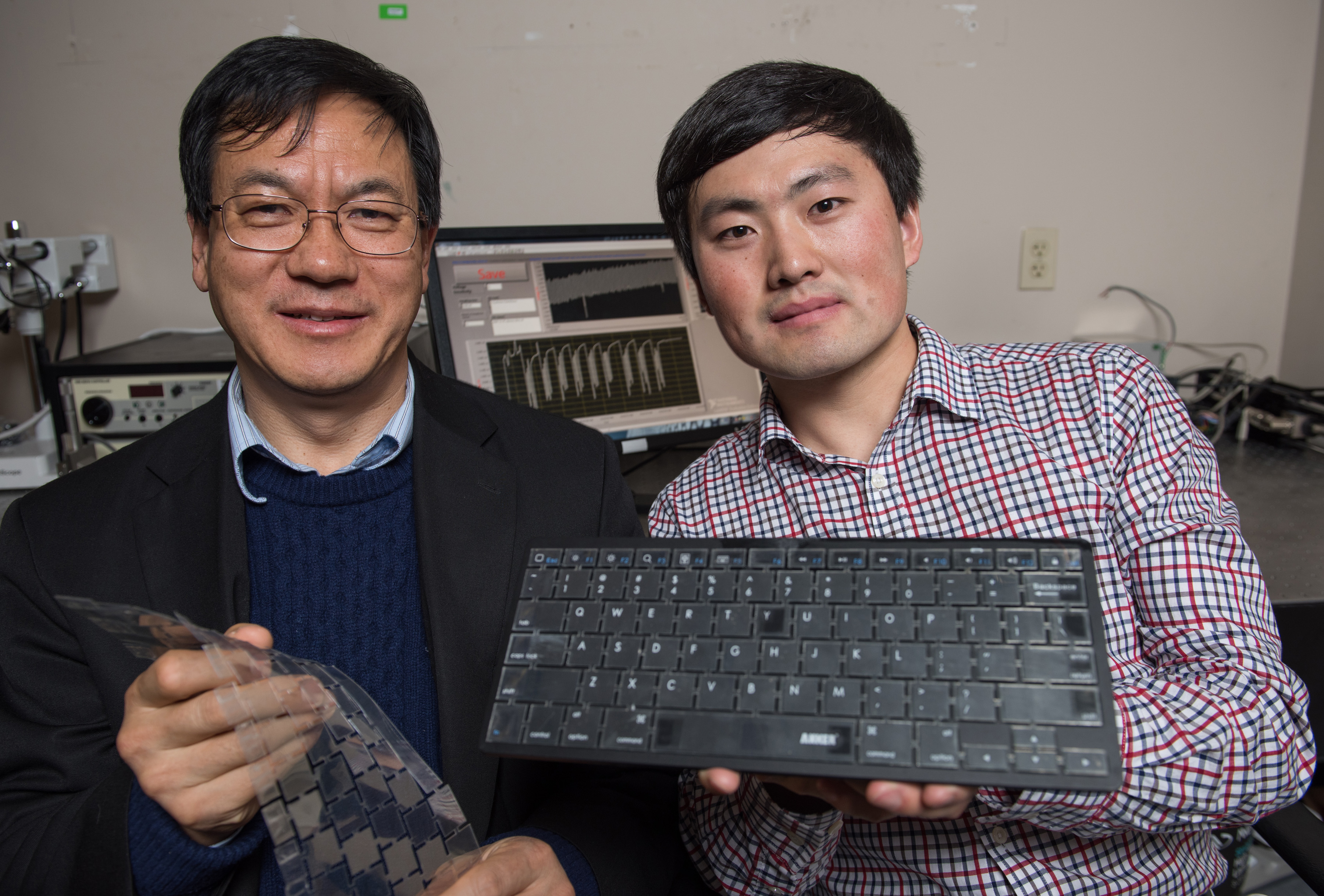Self-powered intelligent keyboard could provide a new layer of security

Georgia Tech Professor Zhong Lin Wang (left) and graduate research assistant Jun Chen display their new self-powered keyboard. The device could provide a stronger layer of security for computer users. (Credit: Rob Felt)
By analyzing such parameters as the force applied by key presses and the time interval between them, a new self-powered non-mechanical intelligent keyboard could provide a stronger layer of security for computer users. The self-powered device generates electricity when a user’s fingertips contact the multi-layer plastic materials that make up the device.
“This intelligent keyboard changes the traditional way in which a keyboard is used for information input,” said Zhong Lin Wang, a Regents professor in the School of Materials Science and Engineering at the Georgia Institute of Technology. “Every punch of the keys produces a complex electrical signal that can be recorded and analyzed.”
Conventional keyboards record when a keystroke makes a mechanical contact, indicating the press of a specific key. The intelligent keyboard records each letter touched, but also captures information about the amount of force applied to the key and the length of time between one keystroke and the next. Such typing style is unique to individuals, and so could provide a new biometric for securing computers from unauthorized use.
In addition to providing a small electrical current for registering the key presses, the new keyboard could also generate enough electricity to charge a small portable electronic device or power a transmitter to make the keyboard wireless.
An effect known as contact electrification generates current when the user’s fingertips touch a plastic material on which a layer of electrode material has been coated. Voltage is generated through the triboelectric and electrostatic induction effects. Using the triboelectric effect, a small charge can be produced whenever materials are brought into contact and then moved apart.
“Our skin is dielectric and we have electrostatic charges in our fingers,” Wang noted. “Anything we touch can become charged.”
While the self-powered feature could provide a convenience benefit and potentially eliminate the need for batteries in wireless keyboards, Wang believes the major impact of the device may be in helping to secure computers by using individual typing patterns or habits as a biometric.
“This has the potential to be a new means for identifying users,” he said. “With this system, a compromised password would not allow a cyber-criminal onto the computer. The way each person types even a few words is individual and unique.”
To evaluate the authentication potential of the keyboard, the research team asked 104 persons to type the word “touch” four times, and recorded the electrical patterns produced. Using signal analysis techniques, they were able to differentiate individual typing patterns with low error rates, Wang said.
Instead of individual mechanical keys as in traditional keyboards, Wang’s intelligent keyboard is made up of vertically-stacked transparent film materials. Researchers begin with a layer of polyethylene terephthalate between two layers of indium tin oxide (ITO) that form top and bottom electrodes.
Next, a layer of fluorinated ethylene propylene (FEP) is applied onto the ITO surface to serve as an electrification layer that generates triboelectric charges when touched by fingertips. FEP nanowire arrays are formed on the exposed FEP surface through reactive ion etching.
The keyboard’s operation is based on coupling between contact electrification and electrostatic induction, rather than the traditional mechanical switching. When a finger contacts the FEP, charge is transferred at the contact interface, injecting electrons from the skin into the material and creating a positive charge.
When the finger moves away, the negative charges on the FEP side induces positive charges on the top electrode, and equal amounts of negative charges on the bottom electrode.
Consecutive keystrokes produce a periodic electrical field that drives reciprocating flows of electrons between the electrodes. Though eventually dissipating, the charges remain on the FEP surface for an extended period of time.
Wang believes the new smart keyboard will be competitive with existing keyboards, in both cost and durability. The new device is based on inexpensive materials that are widely used in the electronics industry.
As part of the study, his research group evaluated the keyboard under challenging conditions, including application of moisture, dirt and oil. “You could pour coffee on the keyboard, and it would not be damaged,” said Wang. “Because it is based on a sheet of plastic, liquids will not hurt it.”
The research was reported December 30 online in the journal ACS Nano. It was sponsored by the U.S. Department of Energy’s Office of Basic Energy Sciences.
In addition to Wang, the research team included first author Jun Chen from Georgia Tech’s School of Materials Science and Engineering; Guang Zhu from the Beijing Institute of Nanoenergy and Nanosystems; Jin Yang from Chongqing University; Qingshen Jing, Peng Bai, Weiqing Yang, and Yuanjie Su from Georgia Tech; and Xuewei Qi from the University of California, Riverside.
This material is based on work supported by the U.S. Department of Energy under award DE-FG02-07ER46394. Any opinions, findings, and conclusions or recommendations expressed in this material are those of the authors and do not necessarily reflect the views of the DOE.
CITATION: Jun Chen, et al., “Personalized Keystroke Dynamics for Self-Powered Human-Machine Interfacing,” (ACS Nano 2014). http://pubs.acs.org/doi/abs/10.1021/nn506832w
Research News
Georgia Institute of Technology
177 North Avenue
Atlanta, Georgia 30332-0181 USA
Media Relations Contacts: John Toon (jtoon@gatech.edu) (404-894-6986) or Brett Israel (brett.israel@comm.gatech.edu) (404-385-1933).
Writer: John Toon